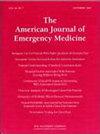Comparison of anticoagulation reversal strategies for warfarin associated acute gastrointestinal bleeding
IF 2.7
3区 医学
Q1 EMERGENCY MEDICINE
引用次数: 0
Abstract
Objective
Gastrointestinal bleeding (GIB) is a common complication associated with warfarin use. However, the optimal approach for anticoagulation reversal—whether with prothrombin complex concentrate (PCC), fresh frozen plasma (FFP), vitamin K (intravenous or oral), or no reversal—remains unclear as current literature and society guidelines do not provide definitive recommendations.
Methods
A retrospective analysis of emergency department patients with warfarin-associated GIB who presented to an academic health system was performed, comparing reversal with PCC, FFP, vitamin K only, or no reversal agent. The primary outcome was 30-day all-cause mortality. Secondary outcomes included rebleeding events and 30-day thrombotic events. Standardized guidelines for reporting were followed (STROBE).
Results
Of 815 patients, within 12 h of presentation, 10.7 % received reversal with PCC (with or without vitamin K), 12.9 % with FFP (with or without vitamin K), and 34.9 % with vitamin K alone; 41.5 % of patients received no reversal agent. Compared to all other groups, patients receiving PCC had significantly higher 30-day mortality (18.4 % [PCC] vs 5.7 % [FFP] vs 4.6 % [vitamin K] vs 5.6 % [no reversal], p < 0.001), which remained significant after adjusting for hemodynamic instability and ICU admission. There were no significant differences in rates of thrombotic event within 30 days (3.4 % vs 3.8 % vs 1.4 % vs 1.2 %, p = 0.20).
Conclusions
Patients who received PCC had a threefold increase in mortality compared to FFP, vitamin K alone, or no reversal, even after adjusting for severity of the bleeding. Further research is necessary to understand factors leading to this observed mortality difference among patients with warfarin related GIB.
华法林相关急性消化道出血抗凝逆转策略的比较
目的:胃肠道出血(GIB)是华法林的常见并发症。然而,抗凝逆转的最佳方法-凝血酶原复合物浓缩物(PCC),新鲜冷冻血浆(FFP),维生素K(静脉注射或口服),还是不逆转-仍然不清楚,因为目前的文献和社会指南没有提供明确的建议。方法回顾性分析急诊科就诊的华法林相关性GIB患者,将逆转与PCC、FFP、仅维生素K或不使用逆转药物进行比较。主要终点为30天全因死亡率。次要结局包括再出血事件和30天血栓事件。遵循了标准化的报告准则(STROBE)。结果在815例患者中,在就诊后12小时内,10.7%的患者接受了PCC逆转治疗(含或不含维生素K), 12.9%的患者接受了FFP逆转治疗(含或不含维生素K), 34.9%的患者单独服用维生素K;41.5%的患者未使用逆转药物。与所有其他组相比,接受PCC的患者30天死亡率明显更高(18.4% [PCC] vs 5.7% [FFP] vs 4.6%[维生素K] vs 5.6%[无逆转],p <;0.001),在调整了血流动力学不稳定性和ICU入院情况后,这一差异仍然显著。30天内血栓形成事件发生率无显著差异(3.4% vs 3.8% vs 1.4% vs 1.2%, p = 0.20)。结论:与单纯使用FFP和维生素K相比,接受PCC治疗的患者死亡率增加了三倍,甚至在调整了出血的严重程度后也没有出现逆转。需要进一步的研究来了解导致华法林相关GIB患者死亡率差异的因素。
本文章由计算机程序翻译,如有差异,请以英文原文为准。
求助全文
约1分钟内获得全文
求助全文
来源期刊
CiteScore
6.00
自引率
5.60%
发文量
730
审稿时长
42 days
期刊介绍:
A distinctive blend of practicality and scholarliness makes the American Journal of Emergency Medicine a key source for information on emergency medical care. Covering all activities concerned with emergency medicine, it is the journal to turn to for information to help increase the ability to understand, recognize and treat emergency conditions. Issues contain clinical articles, case reports, review articles, editorials, international notes, book reviews and more.

 求助内容:
求助内容: 应助结果提醒方式:
应助结果提醒方式:


